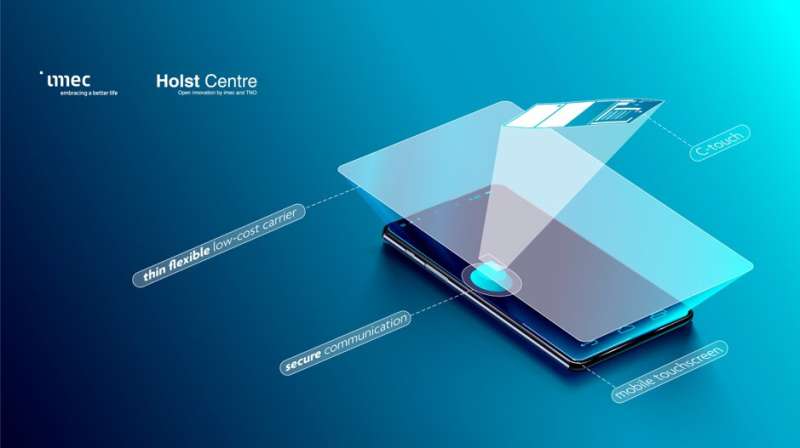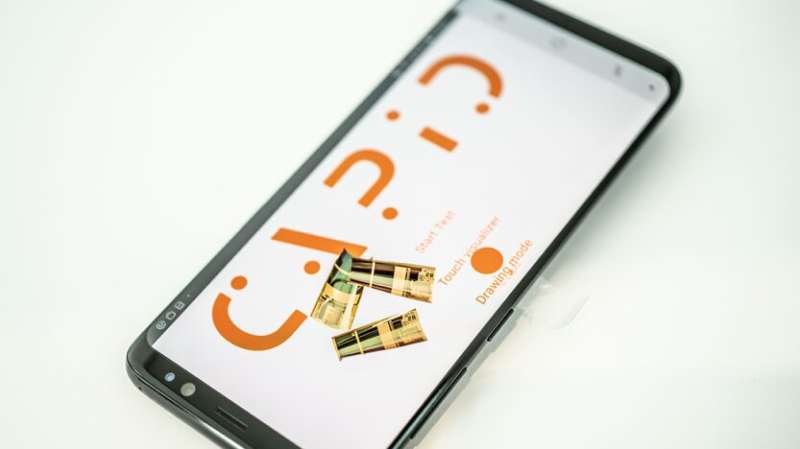January 17, 2020 feature
Thin-film identification tags for transferring data to touchscreen devices

Today, countless electronic devices have touchscreens, including smart phones, tablets and smart home appliances. Touchscreen interfaces have become some of the most common means for users to communicate with and browse through their devices.
With this in mind, a research group at imec in Belgium has recently carried out a study exploring the potential of touchscreen interfaces for enabling the simple transfer of data to and from devices connected to the internet. In a paper published in Nature Electronics, the team showed that commercial touchscreens can be used as reader interfaces for capacitive coupled data transfer using a 12-bit, thin-film identification tag powered by a battery or photovoltaic cell.
"Our field of expertise is flexible electronics for IoT and Internet of Everything applications," Kris Myny, principal scientist at imec and one of the researchers who carried out the study, told Tech Xplore. "In this field, we look into thin-film circuits, i.e. flexible RFID tags that can be embedded in objects and communicate to RFID and/or NFC readers. Based on this, our next step was to investigate whether we could expand the number of readers."
Myny and his colleagues discovered that touchscreens are currently more readily available than RFID readers. This observation inspired them to investigate whether a thin-film chip can communicate directly with a standard capacitive touchscreen.
In collaboration with Cartamundi, manufacturer of cards and board games, the researchers created an app that can visualize and detect touchscreen events (e.g., touch, swipe, etc.) and report on the parameters it detects. Subsequently, they developed a thin-film touchscreen identification tag, placed it on the screen of a smartphone device and read it through their app.
"The app returned csv data points on the events imposed by our tag, which generated a list of swipe events," Myny said. "The coordinates of the swipes as a function of time resulted in a graph displaying exactly our transferred ID."

The touchscreen tags created by Myny and his colleagues enable the quick transfer of data to and from most touchscreen devices. An important advantage of their method is that it does not require changes in the firmware of current touchscreen devices. Instead, it only relies on the use of an app that can automatically decipher the transmitted ID.
"The main challenge we encountered when developing our method was to power the chip in a meaningful manner," Myny said. "This has been achieved using a thin, potentially flexible, photovoltaic cell that captures the light from the smartphone, as most of touchscreens also include a display."
The touchscreen tag developed by the researchers is a 12-bit, thin-film capacitive identification tag with a 0.8cm2 monolithic antenna, employing 439 transistors and with an asynchronous data rate of up to 36 bps . Interestingly, the tag is powered using a thin-film photovoltaic cell that derives energy directly from a smart phone or tablet's display, dissipating only 31 nW of power at a supply voltage of 600 mV.
"If the industry picks this technology up, we may have the opportunity to introduce new flexible touchscreen tags that can communicate to everyday objects with a touchscreen, such as smart fridges, cars with touchscreens, or tablets," Myny said.
The study by Myny and his colleagues introduces a new promising method to achieve fast capacitive coupled data transfer to and from many IoT devices. In the future, the tags they developed could be used to directly communicate with any device that has a touchscreen component, including smart fridges, watches, and cars.
"Our research focuses on IoT and IoE," Myny said. "The next big step for us would be to add sensors to the RFID tags or the touchscreen tags, targeting sensor RFIDs. A big application field we envision is in healthcare, where we could start to monitor the biomedical parameters of patients (such as ECG) over time, allowing for a more effective home recovery in patients."
More information: Nikolaos Papadopoulos et al. Touchscreen tags based on thin-film electronics for the Internet of Everything, Nature Electronics (2019). DOI: 10.1038/s41928-019-0333-z
© 2020 Science X Network



















